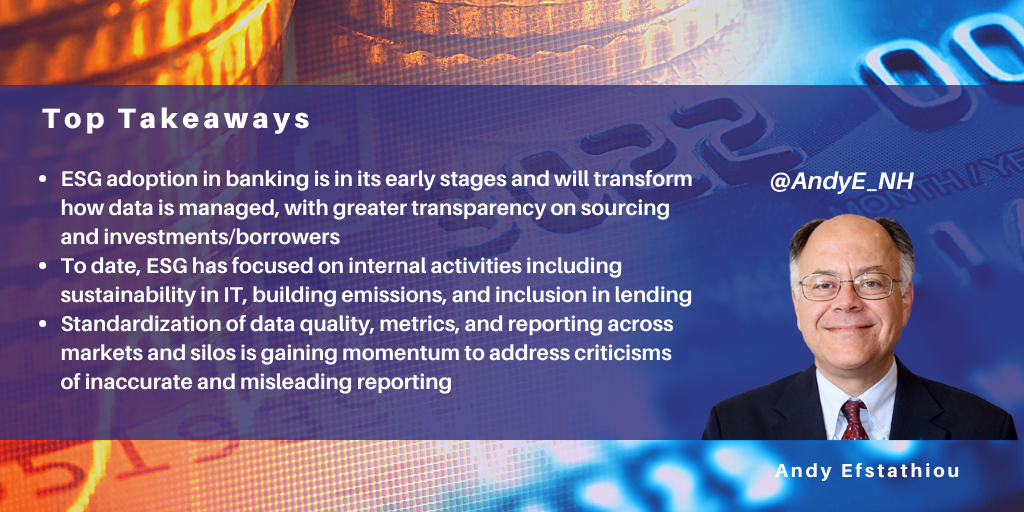posted on Nov 30, 2023 by Andy Efstathiou

ESG services are an emerging set of tracking and reporting capabilities for enterprises. Emerging technologies do not mature in a straight line but cycle through peaks and valleys of development and adoption as they mature. In the past year, ESG services have passed from the euphoria stage of market adoption to the valley stage as the hype has been confronted by the real-world challenges of failure to meet expectations and outright fraud in some cases.
I am currently conducting a market assessment of how ESG services are transforming the banking sector, and here are some early findings.
ESG in Banking: early findings
The financial services industry is an early adopter of ESG reporting due to regulations that set implementation deadlines, and because of the data-heavy nature of the business.
Adoption is currently immature but is growing rapidly. Financial institutions are applying 60% of their efforts to environmental services, 30% to social services, and 10% to governance services. Social and governance initiatives are growing faster than environmental initiatives.
Currently, 70% of banks’ ESG initiatives are internal business activities, 20% investing and lending, and 10% supply chain activities (banks have small supply chains relative to manufacturing, wholesale, and retail).
Also, 80% of ESG activities have been focused on reporting, primarily for regulatory purposes. The remaining 20% of activities have focused on mitigating adverse ESG outcomes. As financial institutions are enabling better reporting, they are now accelerating their mitigation efforts.
Adoption is highest in Europe because its regulations are stricter than in other geographies, with earlier implementation deadlines. North America has the second highest level of ESG adoption. Regulations for ESG adoption in North America and Europe generally follow the same principles, with Europe implementing its regulatory deadlines earlier and with higher remediation hurdles. The rest of the world lags behind these two markets in adoption and has far less consistency in applying principles.
The adoption of ESG services in banking is concentrated in the following processes:
- Green IT: banks do not engage in manufacturing but manage large amounts of data. As such, their primary activities are delivered by IT systems. Reducing a bank’s carbon footprint in IT services is the primary path to increasing sustainability in bank operations
- Inclusion in lending/saving: a large percentage of all populations do not have formal banking relationships. Banks are reaching out to underbanked people as part of their social initiatives to provide banking services to unbanked consumers. The country with the highest level of activity in this area in India
- Rating investments based on ESG criteria for wealth and asset managers. This has been driven by regulation and customer preference. Sourcing, managing, and reporting the data is a massive undertaking, the buildout of which remains ongoing
- Rating carbon emissions data for real estate (buildings). Banks own, invest in, and finance real estate. Sourcing, managing, and reporting this data is more mature than for investments, but it is still an area that is growing
- Governance: financial institutions have fiduciary responsibilities to customers and regulators. Adapting their internal governance systems to deliver better ESG performance has been an area of growing importance over the past several years. Governance engagements are focused on consulting and change management activities.
Areas of emerging adoption include:
- Green lending: banks are experimenting with lending programs that provide a reduced interest rate when the borrower meets specific ESG requirements
- Standardizing metrics for evaluating the sustainability of suppliers and investments. Much of the pushback on ESG comes from using metrics that do not accurately reflect a company’s sustainability, such as greenwashing. Banks and ESG services vendors are working to identify relevant data and scrub it to make it a better indicator of an enterprise’s actual sustainability
- Standardizing the approach to ESG across lines of business and countries. Currently, multi-national banks have very different approaches to ESG issues across these silos. Banks are moving to standardize their approach to enable brand integrity and build a globally optimum response to ESG challenges.
Many ESG engagements are enhancing banks’ data management capabilities to assess and report on emissions. Below are two examples.
Case 1: British multinational bank and Capgemini
- Challenge: The client wanted to modernize its ESG data operating model and rationalize its data feeds on the emissions in its lending portfolio
- Scope of services:
- Built an ESG data store to measure the bank’s financed emissions
- Enabled tracking at the portfolio level
- Designed target operating model to deliver greater flexibility to changing regulations
- Designed data governance framework
- Benefits:
- Reduction in data sources: 50%
- Cost savings: $1m per year in third-party data sourcing spend
- Improved tracking and analytics capabilities
Case 2: Large capital markets firm and Infosys
- Challenge: The firm wanted to enhance its ESG data management for investments, and wanted to be able to:
- Ingest ESG investment data, validate it, and prepare it to be consumable at the issuer level
- Manage the large and variable number of structured and unstructured ESG data sources
- Scope of services:
- Created roadmap, conducted downstream impact analysis on consumption of ESG
- Vendor solution validation
- Implementation of ESG investments platform on AWS cloud
- Implemented NLP-based AI algorithms to support both structured and unstructured data
- Benefits:
- Productivity gain in data analysis: 50%
- Mapped 5k issuers
- Validated statistical accuracy of 400 ESG metrics
In December, I will be publishing a market assessment of ESG activities in banking, “Transforming the Banking Industry with ESG Services” which will delve deeper into how this global initiative is developing, what banks are doing to address these challenges, and how technology services vendors are supporting this transformation. Though this is a transformation that is still in its early stages, banking is one of the industries making the change quicker due to the regulatory deadlines it faces and its high use of IT services in all its business lines.
